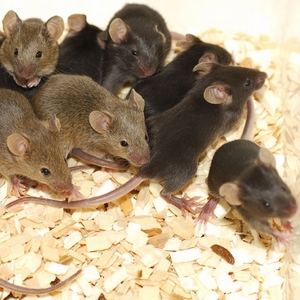Sep. 5, 2008 Research Highlight Biology
What’s in a whiff
Mice have different ways of processing the smell of gender and relatedness
 Figure 1: Much of rodent social communication hinges on the pheromones they secrete.
Figure 1: Much of rodent social communication hinges on the pheromones they secrete.
Mice use only a small number of smell or olfactory receptor cells—which respond exclusively to the urine of males or of females—to discriminate gender, an international research team led by Ron Yu has found. In contrast, information distinguishing strains and individuals is encoded in the combinations or patterns of the cells which are stimulated.
The team worked on sensors in the mouse vomeronasal organ (VNO) at the base of nose to produce the first report of how mice extract such information from smell. It is a step towards understanding how smell impacts behavior, knowledge that could be applied to controlling pest animals.
Previous studies have determined that the chemicals known as pheromones, released by animals into the external environment, play an important role in social communication in rodents (Fig. 1). They trigger hormonal changes and a range of aggression and mating behaviors, and are detected in the VNO by more than 250 individual cell types, each of which carries only one kind of odorant receptor.
In a recent paper in Science 1, the team, including Junichi Nakai from the RIKEN Brain Science Institute in Wako, details its studies on how information on gender and individuals is encoded in smell.
Calcium increases in the cell when a receptor is activated by a pheromone. So the researchers engineered mice which produce a biosensor molecule in VNO receptors that fluoresces when binding calcium. The level of fluorescence detected is proportional to the excitation level of cells activated.
The researchers then exposed thousands of olfactory receptors contained in sections of the VNO of several different individuals to urine of male and female mice. They found that while the urine activated many receptors, less than 1% responded only to male mouse urine and about 2.6% responded exclusively to female urine. When the information from these few cells was removed from the analysis, the urine samples could not be discriminated in terms of gender.
Information on strain and individual identity, however, was encoded in the patterns of cells activated. Littermates, for instance, stimulated about 87.5% of the same receptors as each other; non-littermates only about 36%. Information on the strain of mouse and the stage of the estrus cycle in females is also provided by the combinations of receptors activated.
“We are interested in determining how pheromones relate to behavior,” Nakai says. “We began with the primary sensory neuron, the receptor. Our next target is the accessory olfactory bulb, the next center of information processing.”
References
- 1. He, J., Ma, L., Kim, S-S., Nakai, J. & Yu, C.R. Encoding gender and individual information in the mouse vomeronasal organ. Science 320, 535–538 (2008). doi: 10.1126/science.1154476
